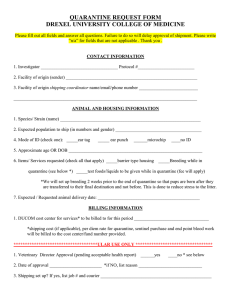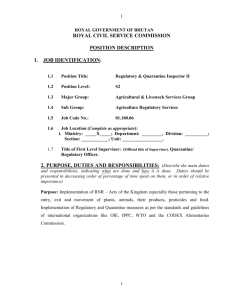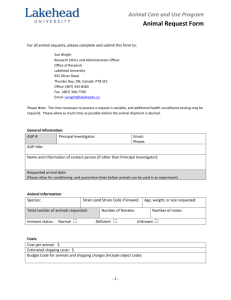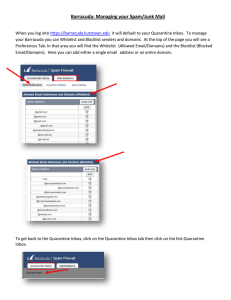Understand Quarantine and Isolation
advertisement
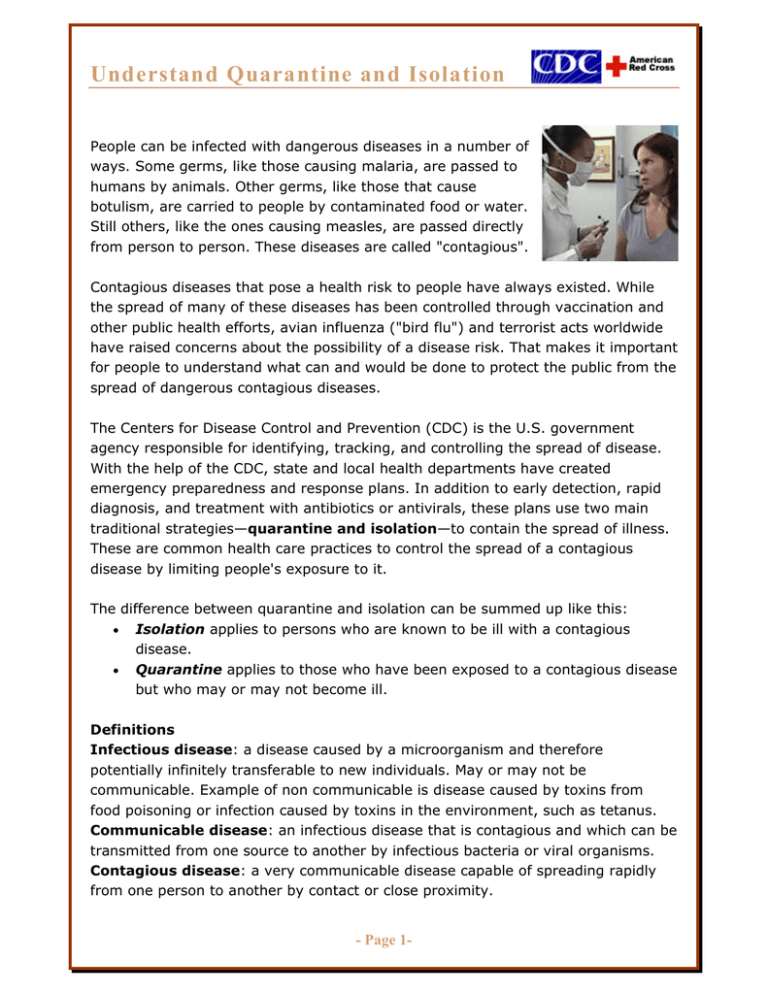
Understand Quarantine and Isolation People can be infected with dangerous diseases in a number of ways. Some germs, like those causing malaria, are passed to humans by animals. Other germs, like those that cause botulism, are carried to people by contaminated food or water. Still others, like the ones causing measles, are passed directly from person to person. These diseases are called "contagious". Contagious diseases that pose a health risk to people have always existed. While the spread of many of these diseases has been controlled through vaccination and other public health efforts, avian influenza ("bird flu") and terrorist acts worldwide have raised concerns about the possibility of a disease risk. That makes it important for people to understand what can and would be done to protect the public from the spread of dangerous contagious diseases. The Centers for Disease Control and Prevention (CDC) is the U.S. government agency responsible for identifying, tracking, and controlling the spread of disease. With the help of the CDC, state and local health departments have created emergency preparedness and response plans. In addition to early detection, rapid diagnosis, and treatment with antibiotics or antivirals, these plans use two main traditional strategies—quarantine and isolation—to contain the spread of illness. These are common health care practices to control the spread of a contagious disease by limiting people's exposure to it. The difference between quarantine and isolation can be summed up like this: • Isolation applies to persons who are known to be ill with a contagious disease. • Quarantine applies to those who have been exposed to a contagious disease but who may or may not become ill. Definitions Infectious disease: a disease caused by a microorganism and therefore potentially infinitely transferable to new individuals. May or may not be communicable. Example of non communicable is disease caused by toxins from food poisoning or infection caused by toxins in the environment, such as tetanus. Communicable disease: an infectious disease that is contagious and which can be transmitted from one source to another by infectious bacteria or viral organisms. Contagious disease: a very communicable disease capable of spreading rapidly from one person to another by contact or close proximity. - Page 1- Understand Quarantine and Isolation Modern quarantine is used when: • a person or a well-defined group of people has been exposed to a highly dangerous and highly contagious disease, • resources are available to care for quarantined people, and • resources are available to implement and maintain the quarantine and deliver essential services. Modern quarantine includes a range of disease control strategies that may be used individually or in combination, including: • Short-term, voluntary home curfew. • Restrictions on the assembly of groups of people (for example, school events). • Cancellation of public events. • Suspension of public gatherings and closings of public places (such as theaters). • Restrictions on travel (air, rail, water, motor vehicle, pedestrian). • Closure of mass transit systems. • Restrictions on passage into and out of an area. Modern quarantine is used in combination with other public health tools, such as: • Enhanced disease surveillance and symptom monitoring. • Rapid diagnosis and treatment for those who fall ill. • Preventive treatment for quarantined individuals, including vaccination or prophylactic treatment, depending on the disease. Modern quarantine does not have to be absolute to be effective. Research suggests that in some cases partial quarantine (that is, quarantine of many exposed persons but not all of them) can be effective in slowing the rate of the spread of a disease, especially when combined with vaccination. Modern quarantine is more likely to involve limited numbers of exposed persons in small areas than to involve large numbers of persons in whole neighborhoods or cities. The small areas may be thought of as "rings" drawn around individual disease cases. Examples of "rings" include: • People on an airplane or cruise ship on which a passenger is ill with a suspected contagious disease for which quarantine can serve to limit exposure to others. • People in a stadium, theater or similar setting where an intentional release of a contagious disease has occurred. - Page 2- Understand Quarantine and Isolation • People who have contact with a infected person whose source of disease exposure is unknown—and therefore may be due to a covert release of a contagious disease. In the aftermath of a disease outbreak or biological attack, there may be dozens of small "rings," each one including the people exposed to a single case of disease. Implementation of modern quarantine requires the trust and participation of the public, who must be informed about the dangers of contagious diseases subject to quarantine before an outbreak or intentional release of biological agents, as well as during an actual event. - Page 3-
